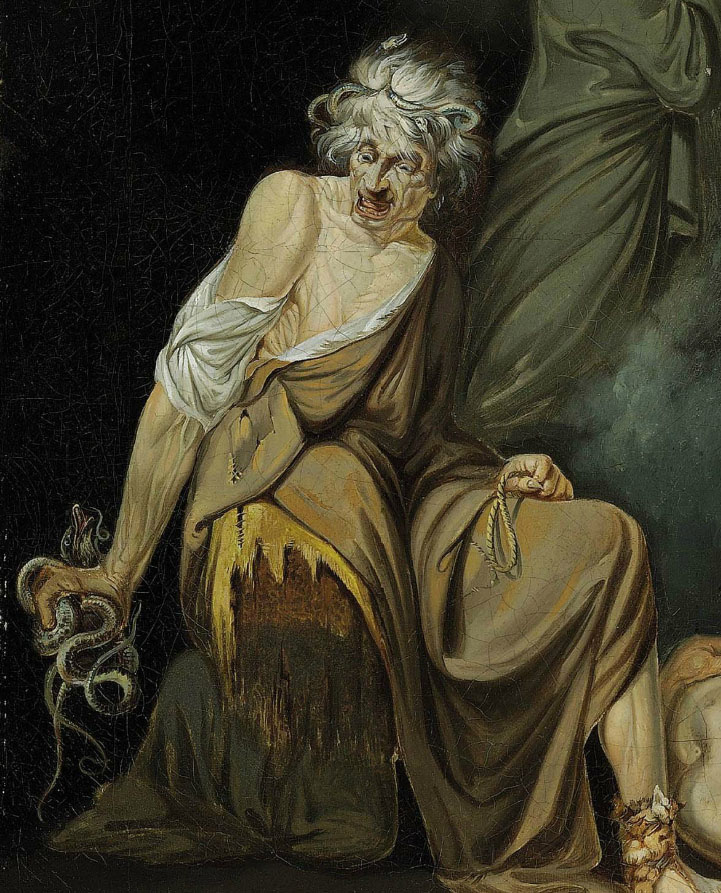
MORE HARPIES! THE RISE OF THE MODERN WOMAN WAS PREDICTED BY THE ANCIENT ROMANS
In the ancient world, the poet was not only a poeta but a vates, a poet-seer inspired by divine powers to unlock truth and beauty, and also the future.
The Romans, I believe, were trying to send us a warning through their vates, one related to the excesses of the modern liberal woman, that shrieking career-wraith haunting nowadays America’s corporate halls.
One can find a few hints in Ovid’s treatment of the vengeful Circe, but this theme of frenzied, screeching, horrific female characters comes to full fruition in Virgil’s Aeneid. As I have written before, this is quite a theme in the Aeneid. Bear with me as I rehash a few old paragraphs.
Virgil of the Golden Age
Virgil’s first such female character is obviously Juno, who like some sort of Sherryl Sandberg is both majestic and completely deranged. Setting the stage on page one, Virgil brings us a Queen of Heavens who is “never-forgetting, “savage” and “wrathful.” Until finally controlled by her divine husband Jove, she is determined to relentlessly persecute Aeneas through lands and seas.
Then there are the Furies, and especially their chief Alecto. Armed with snakes and torches she is the “virgin daughter of eternal night” (virgo sata nocte, more elegantly). She’s a “tear-bringer from infernal shadows,” even her father, Pluto, hates her monstrous being.
Then come my own favorites, the Harpies. Nothing is subtle about these girls, the vulture-bodied, woman-faced monsters of classical mythology. They too are sent to persecute Aeneas and they do so indeed not very subtly by… defecating on his food whenever he sits down to eat.
The Harpies, we are told, are so hellish, horrid, and infernal that “no monster is more wretched, no pestilence more savage, no greater wrath of the gods flows on the waves of the River Styx.”
Virgil adds a wondrously terrifying further description of the Harpies’ looks. The winged creatures’ faces “are of virgins, yet their bowels overflow with the most fetid thing (excrement, we may assume); their hands are taloned and their mouths are ever pale with hunger.”
As a prophecy, both the Furies and the Harpies predict a certain corporate type. Perhaps not winged, but armed with her own torches and snakes in the form of task lists and timesheets. This creature too, like the Harpies who wouldn’t let Aeneas rest, busies herself with permanent and overbearing persecution supported by croaking emails signed with a blood-chilling “Please advise!”
Lucan of the Silver Age
Lucan, a Silver Age vates to follow Virgil by one generation, provided his own prophetic insights. I previously wrote about his political insights. In addition, he as well contributed to the prophecy of the modern hag.
Indeed, Lucan gives us the hag of all hags in the character of Erictho. She is a Thessalian witch portrayed in hilarious Lovecraftian language. By the way, Lovecraft was aware of Lucan and perhaps had even drawn inspiration from him. Back to the matter at hand – Erictho “lives among deserted graves and tombs from which the ghosts have fled.” She is not very pretty: “In filth, her ugly face is possessed by wretchedness.”
More astonishing are her absolutely creepy ways. Fond of that umami flavor of corpses, she avidly unleashes herself on the bodies of the dead. She shoves her fingers through the eye sockets of cadavers and gleefully plucks out the stiff eyeballs. She then finishes it off by chewing on the yellow nails extending from the fingers of the dead.
Erictho does have a sentimental side. If she spots the dead organs of a former loved one, “she then kisses the decapitated head. With her teeth, she pries open the mouth and bites the dead tongue.” In a touching act of Stygian goodbye, Erictho then “whispers and murmurs into the frozen lips, sending spells and blasphemies to the shadows of Hell.”
It’s a little baroque, perhaps even grotesque, but highly enjoyable! And remember, before any slasher movie did it, Lucan had done it first.
As a prophecy, this too points to the advent of certain modern female types. For example, the HR Diversity and Inclusion hags – the hyperactive yet not-very-useful beings gnawing at everything ravenously, but capable of revealing some sentiment: when sending hysterical corporate-wide missives confessing an eternal love to George Floyd.
That bizarre act, the kissing and fondling of the rotting, decapitated head of the deceased, is an image of astonishing prophetic powers. Think about our contemporary Maenads beating their chests and tearing their hair in lamentation for their saintly corpses – George Floyd or Michael Brown – adoring their graffiti portraits, and kneeling solemnly in their memory. More hideous than Erictho, our hags then viciously attack those who dare not partake in their sick sentiments.
The modern hag, resentful and violent towards all, is nonetheless happy to fondle the rotting corpses of the likes of Michael Brown and George Floyd.
Our Own Sad Age of Cheap Aluminum
Given the demonstrated prophetic powers of Virgil and Lucan, the best, or worst, is yet to come! Death, destruction, and pestilence, but also high adventure and exciting romance. Not to mention trips to the underworld and back. In Lucan’s case, to be completely transparent, there isn’t really a return trip, just more death and destruction, but one can’t really have it all.
Follow us on Twitter!
And sign up for updates here!